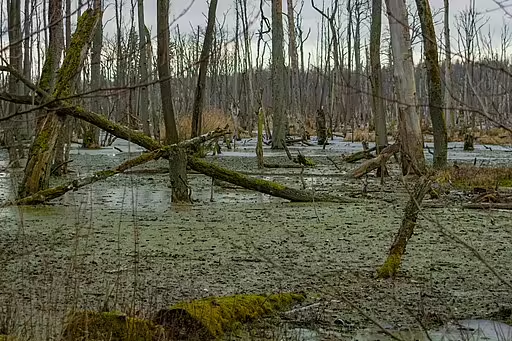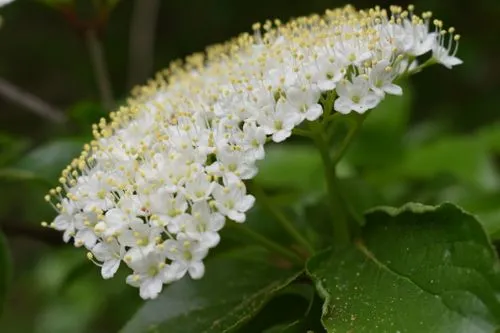Table of Contents for Possumhaw (Viburnum nudum)
Possumhaw (Viburnum nudum) is a shrub that is native to the eastern United States and Canada. This species is a host to the holly blue (Celastrina argiolus), Spring Azure (Celastrina ladon), Henry’s elfin (Incisalia henrici) and the baltimore checkerspot (Euphydryas phaeton). Growing from 5 feet to 15 feet tall, this species grows in moist rich woods, seepage slopes, flatwoods, streambanks, and swamps. The white to cream flowers bloom from April to May and the plant is hardy in zones 5-9.
Taxonomy and Naming of Possumhaw (Viburnum nudum)

Taxonomy
Possumhaw (Viburnum nudum) was originally named and described by Carl Linnaeus, in Species Plantarum in 1753. It has kept this same name since and is a member of the Muskroot Family (Adoxaceae).
Varieties
This species has two varieties:
- Viburnum nudum var. cassinioides: leaf margin crenulate to nearly entire, leaf apex short-accuminate, and winter bud brown to yellow-brown (Go Botany)
- Viburnum nudum var. nudum: leaf margin entire with an obtuse to acute apex, winter buds red-brown (Go Botany)
Meaning of the Scientific and Common Names
Scientific Name
The genus name, Viburnum, derives from the Latin word for obscure or wayfaringtree. The species name, nudum, is a Latin name for “naked.”
Common Name and Alternative Names
The common name comes possibly from the thin bark. Some other common names include witherod viburnum, nanny-berry (Bergen 1894), possum berry (Bergen 1896), and wild raisin.
Physical Description

- Plant Type: This plant is a shrub.
- Height: 5 ft (1.5 m) to 15 ft (4.6 m)
- Stem: The stems are erect with brown to gray bark.
- Leaves: The leaves are simple, opposite, elliptical, obovate to oblong, and have entire (var. nudum) to slightly crenate (var. cassinoides) margins. They are 1 in (2.5 cm) to 6 in (15.2 cm) long and 0.6 in (1.5 cm) to 3 in (7.5 cm) wide.
- Flower color: white to cream
- Blooming period: This plant blooms from April to June.
- Fruiting type and period: This plant has pink to purplish-black drupes that mature in the summer to fall.
Range of Possumhaw in the United States and Canada


This Viburnum is native to the south-central and eastern United States and Canada. Variety cassinoides is considered to be rare in the states of Indiana and Wisconsin and variety nudum is rare in Illinois, Kentucky, New York, Ohio, and Pennsylvania.
Habitat

This species grows in swamps (Wikipedia), seepage swamps (Belden and Derge 2003), sandy bottomed streams – baygalls (Allen, et al 1987), pine barrens (Stone 1907), wet pine flatwoods (Gano and McNeill 1917), wooded seepage slopes (Sundell, et al 1999), and bogs (MacRoberts, et al 2004).
Hosted Insects

This viburnum is a host to the holly blue (Celastrina argiolus), spring azure (Celastrina ladon), Henry’s elfin (Incisalia henrici), the Baltimore checkerspot (Euphydryas phaeton), and the scarce fritillary (Euphydryas maturna).
Other Supported Wildlife

This species is a nectar source to other butterflies, skippers, bees, and wasps during the growing season.
Frequently Asked Questions
Does this plant have any ethnobotanical uses?
The Native American Ethobotanical Database shows that this species has been used for a number of pharmaceutical uses including a oral diseases, convulsions, and as a tonic. This plant is also edible and has been used in foods.
How is this plant distinguished from other Viburnums?
This viburnum is similar to the small-leaf arrow-wood (Viburnum obovatum) and the Nanny-berry (Viburnum lentago). It differs from small-leaf arrow-wood in having leaves that are longer than 5 cm and from nanny-berry in having entire or crenate leaf margins (not serrate margins) (Weakley 2022).
Is this plant invasive?
This species has not been noted as being weedy.
Gardening with Possumhaw

Hardiness
This species is hardy in zones 5-9. If your garden is within these zones and you have the right growing conditions (soil, moisture and exposure), you may well be able to grow this plant. However, if planted outside of its range, the hosted species may not recognize the plant or be harmed by ingesting a different species with an unfamiliar chemical composition.
Optimal Conditions
This species requires full sun to part-shade and medium to wet well-drained soils.
References
- Allen, Charles M., Harland D. Guillory, Charles H. Stagg, Stephen D. Parris, and Roy D. Thomas. 1987. Yellow root (Xanthorhiza simplicissima Marshall) Ranunculaceae new to Louisiana. Phytologia 62(1): 5-6.
- Belden, Allen and Katherine L. Derge. 2003. The flora and fauna of Virginia Army National Guard OMS No. 1 and No. 2 near Sandston, Henrico County, Virginia. Banisteria 22: 22-42.
- Bergen, Fanny D. 1896. Popular American Plant-Names. IV. Botanical Gazette 22 (6): 473-487.
- Bergen, Fanny D. 1894. Popular American Plant-Names. III. Botanical Gazette 19 (11): 429-444.
- Gano, Laura and Jerome McNeill. 1917. Evaporation Records from the Gulf Coast. Botanical Gazette 64 (4): 318-329.
- MacRoberts, Michael H., Barbara R. MacRoberts, and Lynn Stacey Jackson. 2004. Observations of Parnassia grandifolia DC. (Saxifragaceae) in the West Gulf Coast Plain. Phytologia 86: 98-103.
- Stone, Witmer. 1907. The Life-Areas of Southern New Jersey. Proceedings of The Academy of Natural Sciences of Philadelphia 59: 452-460.
- Sundell, Eric, Thomas R. Dale, Carl Amason, Robert L. Stuckey, and John Logan. 1999. Noteworthy Vascular Plants From Arkansas. Sida 18: 877-887.
- Weakley, A.S. and Southeastern Flora Team. 2022. Flora of the southeastern United States. University of North Carolina Herbarium, North Carolina Botanical Garden.


